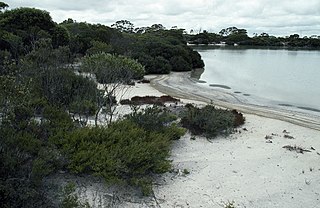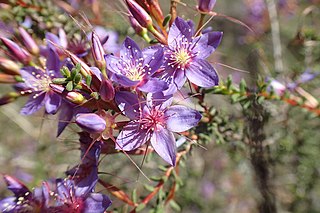
Kunzea salina is a species of flowering plant in the myrtle family, Myrtaceae and is endemic to the south of Western Australia. It is a low, spreading, densely branched shrub with leaves mostly arranged in opposite pairs and usually two sessile pale pink to white flowers arranged at the base of new shoots. It only grows near the edge of certain salt lakes.

Baeckea imbricata, commonly known as heath myrtle, is a species of flowering plant in the family Myrtaceae and is endemic to eastern Australia. It is a shrub with elliptical to egg-shaped or round leaves and small white flowers with five to twelve stamens.
Baeckea latens is a species of flowering plant in the family Myrtaceae and is endemic to the south of Western Australia. It is an upright, spreading shrub with erect, linear leaves and small white flowers with three to ten stamens.
Baeckea pachyphylla is a species of flowering plant in the family Myrtaceae and is endemic to the south of Western Australia. It is a shrub with bilaterally flattened leaves and small white flowers with two to eight stamens.
Baeckea pygmaea is a species of flowering plant in the family Myrtaceae and is endemic to the south-west of Western Australia. It is a slender and erect or spreading shrub with narrowly egg-shaped to almost linear leaves and small white flowers with 12 to 25 stamens.

Calytrix violacea is a species of flowering plant in the myrtle family, Myrtaceae and is endemic to the southwest of Western Australia. It is a shrub with linear to narrowly egg-shaped leaves with the narrower end towards the base, and purple, star-shaped flowers.
Thryptomene caduca is a species of flowering plant in the family Myrtaceae and is endemic to a small area in the north-west of Western Australia. It is a spreading shrub with crowded egg-shaped leaves with the narrower end towards the base, and pink flowers with five petals and seven to nine stamens.
Thryptomene calcicola is a species of flowering plant in the family Myrtaceae and is endemic to a small area in the north-west of Western Australia. It is an erect, sometimes spreading shrub with upwards-pointing linear leaves, and pinkish-mauve flowers with five petals and ten stamens.
Thryptomene dampieri is a species of flowering plant in the family Myrtaceae and is endemic to the north-west of Western Australia. It is a low, spreading shrub with prostrate stems, broadly egg-shaped leaves with the narrower end towards the base, and pinkish flowers with five petals and ten stamens.
Thryptomene globifera is a species of flowering plant in the family Myrtaceae and is endemic to western areas of Western Australia. It is a shrub with crowded, upward-pointing, broadly egg-shaped leaves with the narrower end towards the base, and pale pink or mauve flowers with ten stamens.
Thryptomene hubbardii is a species of flowering plant in the family Myrtaceae and is endemic to a small area in the west of Western Australia. It is a spreading shrub with crowded broadly egg-shaped leaves with the narrower end towards the base, and flowers with five pale pink petals and nine or ten stamens.

Thryptomene mucronulata is a species of flowering plant in the family Myrtaceae and is endemic to Western Australia. It is an erect shrub with upward-pointing, overlapping, egg-shaped leaves with the narrower end towards the base and pink flowers with five petals and ten stamens.
Thryptomene orbiculata is a species of flowering plant in the family Myrtaceae and is endemic to the west of Western Australia. It is a shrub with broadly egg-shaped to more or less round leaves, and flowers with five pinkish petals and usually ten stamens.

Triplarina volcanica is a species of flowering plant in the myrtle family, Myrtaceae and is endemic to Queensland, where it is only found in three mountainous areas. It is a shrub with elliptical to egg-shaped leaves with the narrower end towards the base and flowers with five sepals, five white petals and fourteen to sixteen stamens.
Hibbertia trichocalyx is a species of flowering plant in the family Dilleniaceae and is endemic to the south coast of Western Australia. It is an erect, spreading shrub with oblong to elliptic leaves and yellow flowers with eleven stamens arranged around three glabrous carpels.
Cryptandra micrantha is a flowering plant in the family Rhamnaceae and is endemic to the southwest of Western Australia. It is a prostrate or upright shrub with spiny branchlets, narrowly oblong to elliptic leaves and dense clusters of white or cream-coloured, tube-shaped flowers.
Cryptandra minutifolia is a flowering plant in the family Rhamnaceae and is endemic to the south-west of Western Australia. It is a spreading shrub with oblong to elliptic leaves and clusters of white or pink, tube-shaped flowers.
Cryptandra monticola is a flowering plant in the family Rhamnaceae and is endemic to the south-west of Western Australia. It is an erect or spreading shrub with linear or narrowly oblong to elliptic leaves and head-like clusters of white, tube-shaped flowers.
Cryptandra nola is a flowering plant in the family Rhamnaceae and is endemic to the western region of Western Australia. It is an erect or spreading, spiny shrub with oblong to elliptic leaves and clusters of white, tube-shaped flowers.
Pimelea subvillifera is a species of flowering plant in the family Thymelaeaceae and is native to the south-west of Western Australia and to South Australia. It is usually an erect shrub and has elliptic leaves and heads of white flowers surrounded by 8 to 18 narrowly egg-shaped involucral bracts.





